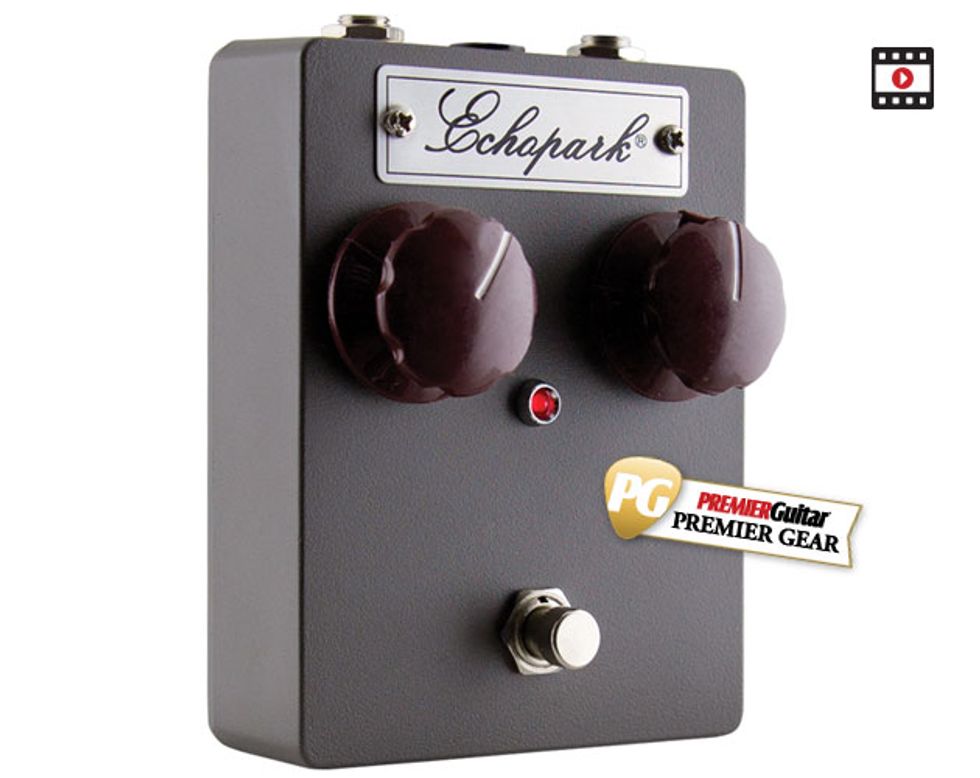Although Echopark isn’t a household name, sharp-eyed guitar spotters have no doubt noticed the company’s wares in rock ‘n’ roll circles. The instruments from Gabriel Currie’s little L.A. workshop exhibit a cool mix of classic solidbody design, tasteful sensibilities, and the precision of a builder that apprenticed under Leo Fender at G&L. But Currie’s instincts about pickups and electronics, as well as his fastidious sense of build quality, means his guitars are tough, practical sonic tools.
Now Echopark is in the fuzz business. And in the F-1 Fuzz, he’s applied his obsessions for granite-tough build quality and twisted-but-classic sounds to a spartan, vintage-inspired box that can sound positively magical.
Simple Duality
The F-1 houses its super-tidy, hand-wired circuitry in a humble, industrial gray powder coated enclosure. With it’s big Bakelite-style knobs, it would look at home among any of the first wave of fuzz pedals from the mid-’60s. The pedal can be run off a 9V adapter or a battery, though vintage fuzz devotees will undoubtedly opt for the battery.
The F-1’s clean, streamlined look might seem too minimal. There are no markings explaining the roles those knobs play in shaping sound. Then again, operating the F-1 is not rocket science: About 30 seconds of tinkering reveals that the pedal’s left knob controls volume, while the one on the right controls gain.
That simplicity is a bit deceptive, however. This is a gain knob with a twist. From 6 o’clock to 12 o’clock, the gain section utilizes just one of the pedal’s two germanium transistors. Past the halfway point, the knob begins to cascade the first transistor’s output into the second, blending the output in a way that adds dirt and changes the texture of the fuzz. Specifically, the two transistors blended add a bit of fizziness and sparkle to the top end without deleting any low-end beef. And at the most extreme settings they add an almost swirling, phased effect that recalls a vintage Fuzz Face. In general, the F-1 boasts a remarkable harmonic richness that pushes leads through and over any mix without becoming harsh.
Ratings
Pros:
Remarkably great fuzz tones and touch sensitivity. Killer, streamlined looks. Easy to use.
Cons:
A bit expensive.
Tones:
Ease of Use:
Build/Design:
Value:
Street:
$230
Echopark F-1 Fuzz
echoparkguitars.com
Fuego Gris
The F-1 balances brashness and musicality in a way that can make the simplest riffs sound massive. High notes and leads ring with great sustain and tasty compression that you can transform into exceptionally controllable feedback. Low notes have a high-calorie chewiness, textured dirt, and a chunky saturation that sacrifices nothing in the way of focus. Like any germanium fuzz worth its salt, the F-1 is extremely touch sensitive and feels very responsive to changes in pick attack and guitar volume. In fact, the F-1 becomes a nice taut overdrive as you roll off guitar volume—although the wide-open settings are so addictive that I rarely used the pedal in this context.
The F-1 is powerful enough to turn any clean amp into a beast, but it melded in particularly pleasing ways with high-headroom Marshall-inspired circuits and tube amps at the verge of breakup. And while many fuzzes disappear or sound just plain crappy when mated to higher-gain amps, the F-1 excelled at driving dirty sounds into zones from fiery to outrageous. And while the lack of an EQ or tone function may look like a deal-breaker for players who think they need more control, the F1 is excellent at enhancing the EQ attributes and color of an amp without sacrificing any of its personality or power. I rarely needed to adjust the EQ knobs on my amps when the F-1 was on.
The Verdict
The Echopark F1 is a foolproof, musical, and explosive fuzz pedal that, while far from subtle, feels very integrated and at home with almost any amp/guitar combo. While there are a lot of very nice fuzz options to consider in this price range—many with a more diverse feature set—few are as inspiring or satisfying in sound and feel. And for $230, it’s a great way to get ahold of some of that Echopark voodoo that has charmed so many rock stars in recent years.
Watch the Review Demo:





![Rig Rundown: Russian Circles’ Mike Sullivan [2025]](https://www.premierguitar.com/media-library/youtube.jpg?id=62303631&width=1245&height=700&quality=70&coordinates=0%2C0%2C0%2C0)


























